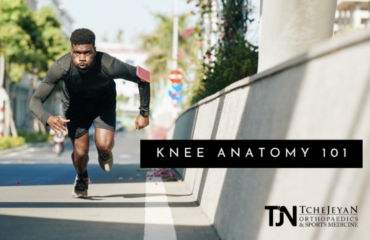Tendonitis is the inflammation of a tendon–the tissues that connect muscle to bone. Patellar tendonitis, then, is an injury that affects the tendon connecting your kneecap (patella) and your shinbone. Patellar tendonitis is commonly found in athletes, especially those participating in sports requiring sudden explosive movements, such as jumping. As a result, it is also referred to colloquially as jumper’s knee. If you suffer from this condition, seeking treatment is the best way to minimize pain and maintain joint mobility.
Cause
Tendonitis doesn’t happen from one, single event. Instead, it is the accumulation of repeated movements that stress a joint. Patellar tendonitis occurs when the patellar tendon tissue experiences tiny tears or becomes inflamed from overuse. When the knee tendons are repeatedly forced beyond their limits, the patellar tendon eventually becomes sore and loses strength.
The condition is common in athletes who participate in sports like basketball, volleyball, football, figure skating, hockey and running, where the knee joint gets repeatedly used in the same movement, with significant weight loads placed on the joint. It is also common in dancers or people who have jobs that involve repetitive motion of the knees, such as crouching down or bending the knees to lift objects, or walking up and down stairs or steps. For example, a delivery driver who has to get on and off his truck repeatedly throughout the day carrying heavy boxes might develop patellar tendonitis.
Symptoms
Pain onset is usually gradual and often begins as an ache directly below the kneecap. At first, you may feel pain only occasionally following practices or games or at the end of the day, but it will steadily increase until the pain is present during movement. It will be accompanied by stiffness of the joint, and it may make the extension of the joint challenging. Activities that utilize the patellar tendon, such as squats and walking downhill or down a flight of stairs, will cause pain to intensify.
Diagnosis
To diagnose this condition, your healthcare provider will ask about your medical history, activity level, and symptoms. It is important to inform your doctor whether your symptoms have changed over time or become worse under specific circumstances.
Next, your healthcare provider will complete a physical exam and manipulate your knee to gauge your mobility. Depending on how long you have been experiencing pain, an MRI may be performed so your doctor can see how much structural damage there is in your tendon. Then, your doctor will make some recommendations.
Consequences of Failing to Treat Patellar Tendonitis
If you choose to do nothing to treat tendonitis, here’s what you can expect to happen.
As time goes on, the symptoms accompanying the tendonitis will continue: pain, stiffness, loss of mobility. This can make completing everyday tasks difficult. As the patellar tendon is an essential component of the extensor mechanism (the parts of the knee that allow you to extend your leg), the inflammation and damage to this tendon can make extending the leg uncomfortable and impact your ability to climb stairs or rise from a seated position. If you continue to perform the activity that aggravates your patellar tendon, you risk a patellar tendon tear from the weakened joint.
Unlike tendonitis, which increases in severity over time, patellar tendon tears happen suddenly. Tendon tears may be total or partial, and are usually caused by a sudden movement: a jump or sudden change in direction. While a partial tear may be able to heal with rest, a complete tear will require surgery and physical therapy to regain normal movement.
Treatment for Patellar Tendonitis
The severity of your tendonitis will determine the treatment method you use. The general recipe for treatment is RICE: rest, ice, compression, and elevation. Your doctor will likely instruct you to stay off your feet and apply ice to the injured tendon in 15-minute intervals several times a day. Protective devices, such as braces and wraps, may benefit you by offering support to your joint while it heals. And when you are at rest, you should try to elevate the knee, to encourage fluids to flow away from the joint and reduce any swelling.
Physical therapy will also help. Following your rest period, a physical therapist will have you do exercises that strengthen the tissues around your knee and ease the joint back into healthy movement.
For patellar tendonitis, surgery is rarely recommended unless the tears in your patellar tendon are too large to heal on their own.
If you are dealing with knee pain, seek care from a healthcare provider. Catching problems early will prevent them from developing into more severe conditions. To make an appointment for a diagnosis and treatment recommendations, contact Tchejeyan Orthopaedics and Sports Medicine today.




